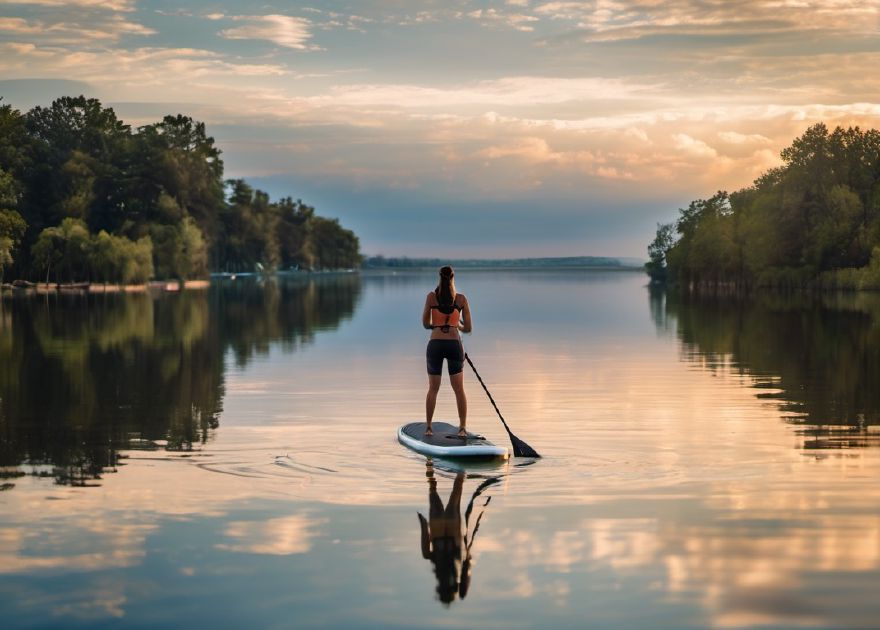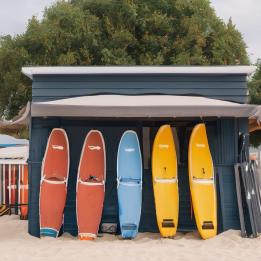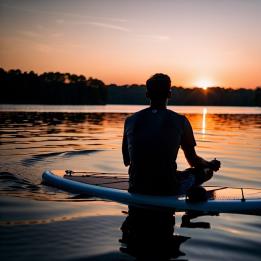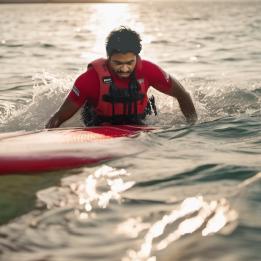Everything You Need to Know When Learning to Paddleboard

Learning to paddleboard for the first time can be intimidating. Balancing on a wobbly board while paddling takes coordination and skill. But with the right preparation and technique, you’ll be stand up paddleboarding with ease in no time.
I’m going to break down everything you need to know to successfully learn paddleboarding. Let’s get started!
Choosing the Right SUP Gear
Having the proper SUP equipment makes learning to paddleboard much easier. Here’s what you need to get started:
Board
For beginners, an inflatable SUP is recommended. They are stable, durable and easy to transport and store. Look for an all-around board that is at least 10 to 11 feet long and 30+ inches wide for stability.
Our guide will help you to choose the perfect paddleboard for learning.
Paddle
Get an adjustable aluminum paddle around 7 to 8 feet long so you can tweak the length as you get better. The right paddle length lets you paddle efficiently.
Life Jacket
A U.S. Coast Guard-approved life vest provides flotation if you fall and is required in most places. Get a snug, comfortable vest designed for paddleboarding.
Here are some recommended life vests
Leash
Attach an ankle leash to your board so it doesn’t blow away if you fall off. Coiled bungee leashes allow freedom of movement.
Other Essentials
Also gather sun protection, water, proper paddling clothes and a bag to transport your gear. Now you’ve got all the basics covered!
Finding Calm Water for Your First Paddle
When first learning to paddleboard, start out on flat, calm water free of waves or current. Small lakes, ponds and rivers are ideal starting points before venturing out to the ocean. Having a minimal chop will make maintaining balance much easier as a beginner.
If possible, go during low wind conditions for your initial sessions too. Light offshore breezes are fine, but avoid harsh onshore or side winds at first. Learning paddleboarding takes patience - choose conditions set up for success.
Mastering the Basic Paddleboarding Stance
Once you find a suitable spot, get ready to hop on your board! Follow these steps to nail the proper paddleboarding stance:
Start on your knees in the middle of the board and grasp the paddle with both hands.
Place your feet hip-width apart perpendicular to the board. Rise up onto both feet in one smooth motion.
Look straight ahead, not down at your feet. Keep a slight bend in your knees and torso.
Hold the paddle vertically using a shoulder-width grip. Keep your hands low and elbows slightly bent.
Avoid “rigid” arms - hold the paddle in a relaxed grip. Loose limbs will help you balance.
Shift your gaze to one point on the horizon to stay centered. Let your core and legs make minor adjustments to stay upright.
Paddle, balance, glide, repeat - break down the basics and the rest will come
With practice, this balanced SUP stance will start to feel natural. Don’t get discouraged if you wobble at first - it takes time to develop the stability and coordination. Be patient with yourself!
Mastering Forward Paddle Strokes
Balancing on a SUP is just half the battle - you also need to propel yourself forward! The basic technique for proper forward paddle strokes is:
With the paddle extended in front, submerge the blade straight down into the water near your toes.
Pull the paddle back along the side of the board in a straight line until your hand is beside your hip.
Exit the paddle blade before over-extending your arm behind you.
Switch sides and repeat the forward stroke on the opposite side to keep moving straight.
Use slight torso rotation for extra power as you get comfortable.
Keep paddle strokes long, smooth and steady. Rushing leads to splashing and inefficiency. Master this forward stroke technique before moving on to turns and other maneuvers.
Additional Paddleboarding Tips
Here are some final tips to help master learning paddleboarding:
- Start paddling on your knees to get the hang of it first. Then work up to standing.
- Keep practicing your balance on land before hitting the water.
- Look where you want to go, not right in front of the board.
- Keep a loose, relaxed grip on the paddle to avoid fatigue.
- Lean into turns using torso rotation - don’t just rely on paddle strokes.
- Take breaks as needed! Learning proper technique takes sustained effort.
For more tips, check out our complete guide to stand up paddleboarding for beginners.
Patience and persistence are key. With the right preparation and practice, you’ll be paddleboarding like a pro in no time. Have fun learning a rewarding new skill!
Let us know if you have any other questions about learning the basics of paddleboarding. We’re always happy to help out beginners.









